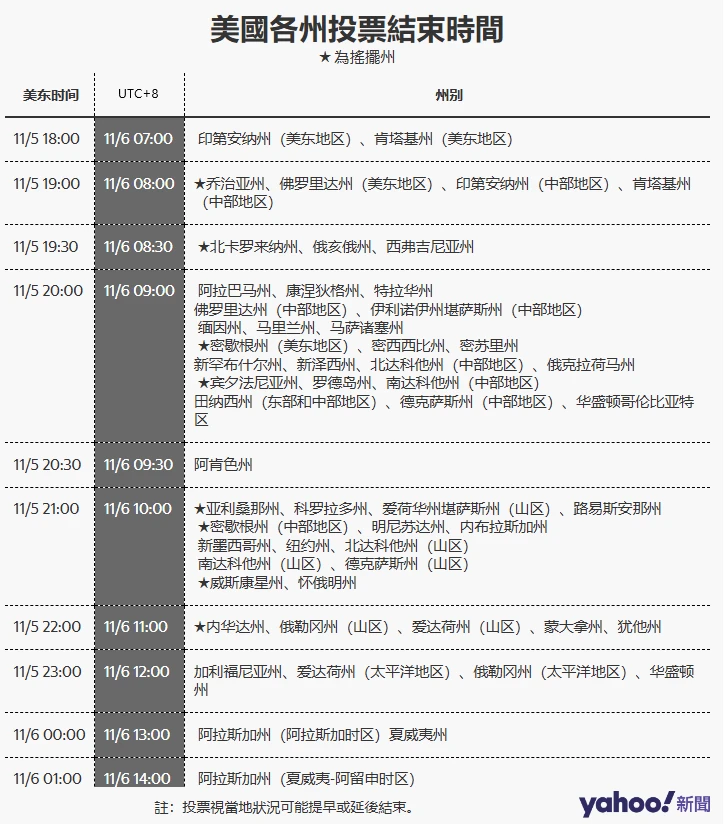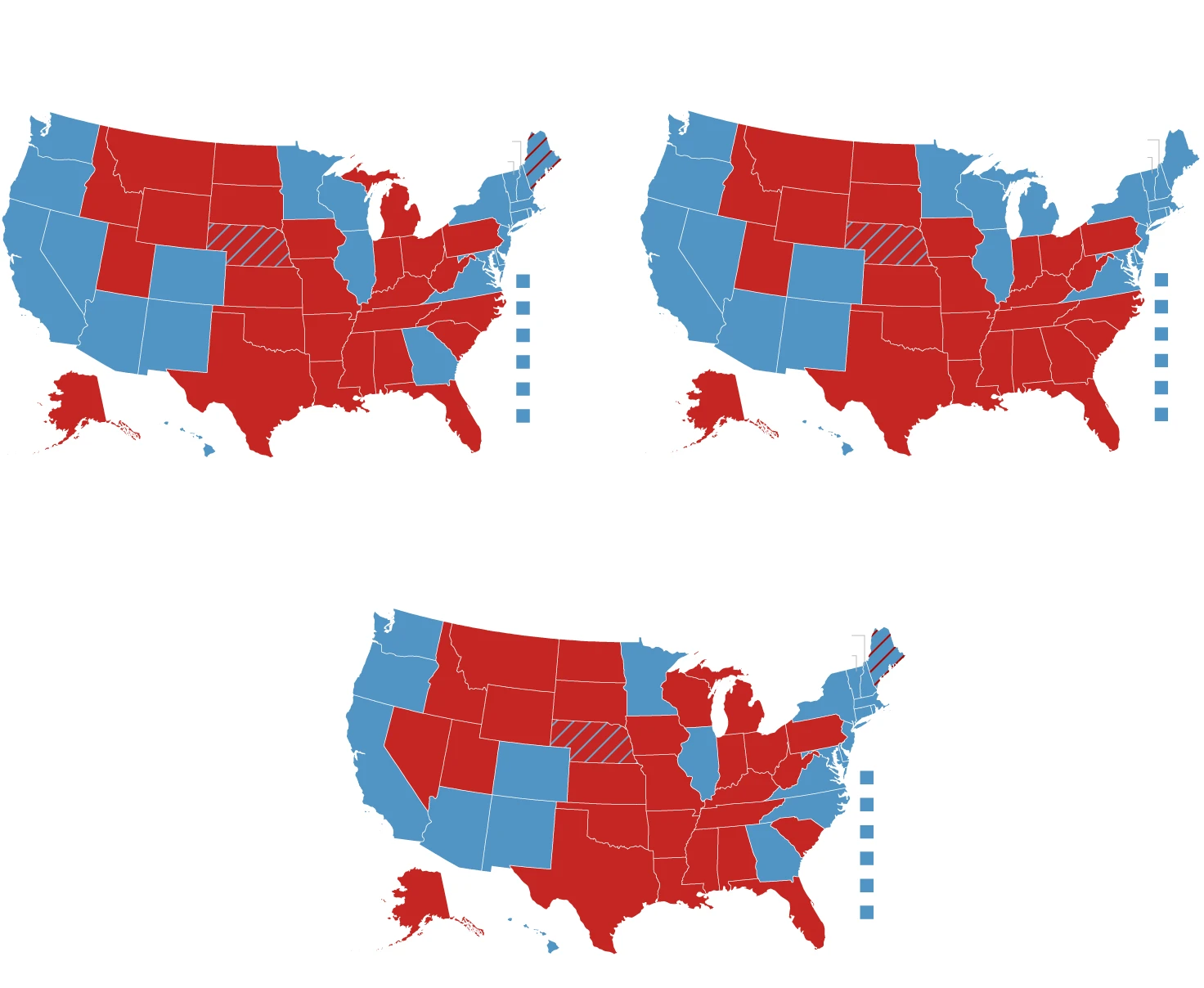原創| Odaily星球日報( @Odaily中國 )
作者:阿祖瑪( @azuma_eth )
美國大選將於明天正式開始,但似乎許多讀者對於何時才能知道最終的選舉結果仍然存在一些疑問。
-
Odaily記:關於美國大選的一些基本概念介紹,可以先閱讀 美國大選前必讀:您需要知道的一切都在這裡 .
一般當晚就能得到初步結果。
根據雅虎財經整理的數據顯示,各州投票將於東部時間11月5日(北京時間11月6日上午7:00)至11月6日凌晨1:00(北京時間14:00)陸續結束,之後各州投票將陸續結束。但由於各州選舉方式、選票處理、計票規則等方面存在差異,各州公佈結果的時間將會有一定差異。
不過,考慮到選舉的現實,選舉的實際走向基本上取決於喬治亞州、北卡羅來納州、密西根州、賓州、亞利桑那州、威斯康辛州、內華達州這7個搖擺州的戰況。其中,喬治亞州將於北京時間11月6日完成州投票,最早,搖擺州中選舉人票最多的戰場州賓夕法尼亞州將於北京時間11月9:00完成州投票6日,內華達州最遲將於北京時間11月6日11點完成州投票。
基於上述情況,CNN等多家美國主流媒體紛紛預測, 一般來說,選舉結果最早在選舉當晚即可初步確定,預計為北京時間11月6日中午或下午。
會不會出現異常狀況?
有一般情況,自然就會有非常情況。
回顧過去236年美國大選的真實歷史,確實存在一些延遲結果的情況。延遲的原因多種多樣,例如選票過於接近甚至平分、多名候選人沒有獲得最低選舉人票數、計票時間意外延長、或者關鍵州因票數分佈過於接近而不得不重新計票…
1800年,美國總統選舉出現了候選人打平的極端情況,這迫使美國修改了選舉規則(但打平的機率仍然很低,下面會詳細解釋) );在1824年的選舉中,沒有候選人獲得足夠的選舉人票。這是歷史上第一次也是唯一一次由眾議院投票選出總統。
即使我們忽略美國200多年的年鑑,21世紀以來的許多大選結果都存在不同程度的延遲 。其中包括川普親自參與的2020年大選,以及選舉日後36天才公佈結果的2000年大選。
2020 年選舉(「延後」4 天)
2020年選舉日為當地時間11月3日(美國大選每四年在11月第一個星期二舉行),但由於疫情影響,選擇郵寄投票的選民大幅增加,這使得還增加了計票所需的時間。
直到11月7日,拜登接連拿下賓州和內華達州兩個搖擺州,獲得超過270張選舉人票後,選舉結果才初步確定。
值得一提的是 這次選舉,川普很早就宣布自己獲勝,在初步結果出來後,他多次批評民主黨選舉舞弊,但最終並沒有改變選舉結果 ——如果哈里斯這次獲勝,不排除川普會引發二次大選…
2000 年選舉(「延後」36 天)
2000年的選舉日是11月7日。到11月8日上午,各州公佈計票結果時,民主黨候選人戈爾已贏得250張選舉人票,共和黨候選人喬治·W·布希以246張選舉人票緊隨其後。所需的270張選舉人票僅一步之遙。
此時,擁有25張選舉人票的佛羅裡達州即將開放投票。無論誰贏得佛羅裡達州,都將直接跨過270票門檻,登上總統寶座。最終,佛羅裡達州宣布布希以微弱優勢贏得該州,但計票結果顯示,布希只比高爾多了1700張選票,僅佔該州總票數的0.03%之差。 根據佛羅裡達州當地法律,當兩名候選人之間的差距小於0.5%時,必須進行重新計票。
11月10日,佛羅裡達州完成機器重新計票,但布希的領先優勢大幅縮小至327票。戈爾立即向當地法院申請人工重新計票。隨後,雙方就是否進行人工重新計票、計票區域範圍、計票期限等問題展開了激烈的法律鬥爭。 直到12月9日,聯邦最高法院才停止了佛羅裡達州的手動重新計票,並於12月11日裁定不再進行手動重新計票,並保留國務卿簽署的投票結果。戈爾最終在12月13日宣布落敗。
此時,距離選舉日已經過了36天。
最極端的情況會是269:269嗎?
回到這次選舉,雖然機率極低,但269:269的平局還是有可能的。
例如,如果哈里斯贏得威斯康辛州、密西根州、亞利桑那州和內華達州,並在內布拉斯加州贏得一張選舉人票(拜登在2020年贏得這些州),但輸掉賓夕法尼亞州和喬治亞州,那麼雙方的票數將為269-269。
如下圖所示,選舉網站 270 獲勝 也列出了其他一些潛在的聯繫。
如果發生這種情況,總統該如何決定?
在下面 第十二修正案 ,在 1800 年選舉後頒布,如果沒有候選人獲得足夠的選舉人票(今天有 270 張), 1 月 3 日宣誓就職的新國會將選出總統,參議院將選出副總統,這一過程被稱為臨時選舉。
根據分析 國會研究服務處 如果出現這種極端情況,國會預計將在1月6日舉行臨時選舉。在這種情況下當選總統的可能性更高。
等等,還有一種更極端的情況——如果眾議院各州代表團在1月20日就職日之前未能選出總統,那麼參議院選出的新副總統將成為臨時總統……但顯然這種可能性很大發生率如此之低,幾乎是不可能的。
等待結果
綜上所述,以上對1800年、1824年、2000年、2020年大選等各種突發事件的介紹,僅說明美國大選結果公佈的時間存在一定的不確定性,但總體而言,市場仍預計白宮新主人將於11月6日初步確定。
您還需要再等一兩天才能看到最終結果。屆時,撲朔迷離的市場走勢或許會變得更加清晰。
本文源自網路:回顧極端歷史情況,美國大選結果最遲何時公佈?
相關:前沿實驗室加密 市場 週報|W37
BTC與ETH本週回顧 市場表現 本週加密貨幣市場整體反彈: 比特幣:本週,比特幣呈現整體反彈走勢。市場交易者對經濟衰退的交易情緒有所緩和,一般認為未來美國經濟出現衰退的機率較低。本周美國8月CPI數據公佈後,可以看出CPI得到了較大緩解,朝著聯準會關注的2%又邁進了一步。因此,大多數市場交易員押注聯準會下週將降息25 BP,這意味著這只是防禦性降息,美國經濟尚未進入衰退…










